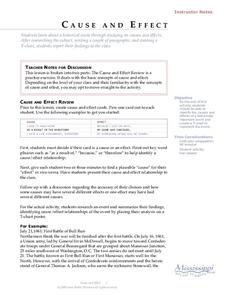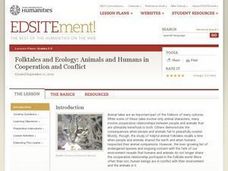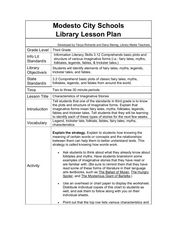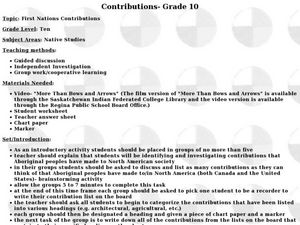Curated OER
Comparing Good and Bad Character Traits of Historical and Current Figures
Students create a chart with two columns. In one column include good and bad character traits of historical figures in biographies and historical fiction. In the second column include good and bad character traits of current famous...
Curated OER
Cause and Effect
In groups, learners they look for key words to help locate a cause and effect relationship. They create a t-chart with the information they discover and share it with the class.
Curated OER
Time Line of the Year
Students record special events and memories on a timeline of the school year. In this timeline lesson, students understand the purpose of a timeline as they chart important events of the school year using photos, drawings, handprints,...
Curated OER
Coordinate Geometry
Grab your class and get them graphing polygons on a coordinate plane! They investigate the four quadrants, discover the x and y axis, and correctly plot ordered pairs. To show their comprehension, each child creates a coordinate picture...
Curated OER
Key It Correctly!
Third graders receive instruction on how to use a keyboarding device or computer. They show the proper technique to type each key as it is called out by the teacher, and also focus on using correct posture when sitting at a computer.
Curated OER
Fraction Spelling
An interesting take on spelling practice is included here! Emerging spellers take their weekly spelling list and create a three-column chart. In the first column, they write the word itself. In the second column, they write how many...
Curated OER
How Long is a Hot Dog? Weight, Weight! Don't tell me!
Primary learners participate in activities that help them explain how different things are measured. They create their own access number chart.
Curated OER
Prewriting Strategies
Fourth graders explore various strategies to overcome fears of writing, and utilize a story map as a prewriting strategy. They read and discuss the steps of the writing process, follow the steps along with the teacher as they discuss the...
Curated OER
Folktales and Ecology: Animals and Humans in Cooperation and Conflict
Story elements such as conflict, character analysis, resolution, and moral are discussed and charted as elementary children read folktales involving animals. An element of science is also introduced as learners discover what a keystone...
Curated OER
Periodic Table of the Elements
First graders discuss, at their level, the concept of elements making up all matter. They discover the story of Dimitri Mendeleev and his discovery of the Periodic Table of the Elements. They locate and color some of the most common...
Curated OER
Simple Probability
Students explore simple probability. Each student spins a spinner and records the result as they enter the room. The recorded results are used to calculate experimental probabilities. After the teacher explains how to calculate...
Curated OER
Allocating Energy from a Photovoltaic System
How much electricity do you use in a day? Physics fanatics calculate their energy use by consulting a chart of the watts required to run typical household appliances. They compare power to amounts of electric energy used or generated....
Curated OER
Ball Identification Exercise
Fourth graders participate in a ball identification exercise to help them identify birds. As a class, their teacher throws them a variety of different sized and colored balls for them to describe. Using these factors, they work together...
Curated OER
Using Details from Text to Identify Author's Purpose
Explore writing techniques by analyzing newspapers and magazines with middle schoolers. They will collaborate in small groups to read local news stories and identify the main ideas and author's intent. They also utilize an information...
Curated OER
Graphing Data
First graders learn how to display data using a bar graph. In this bar graph lesson, 1st graders use data from a t-shirt color survey to make a bar graph. They also make an animal bar graph before interpreting the information.
Curated OER
Characteristics of Imaginative Stories
Third graders explore genre characteristics. In this genre literacy instructional activity, 3rd graders listen to a variety of fiction stories and classify them according to genre. Students identify common features in each genre and...
Curated OER
Laurence Yep's Dragonwings
Students read independently the novel, "Dragonwings," by Laurence Yep and make connections between a text and the world. They summarize, paraphrase, analyze and evaluate skimming and scanning techniques when reading a novel. Each student...
Curated OER
Contributions- Grade 10
Tenth graders investigate the contributions of Aboriginal peoples. In this native studies instructional activity, 10th graders watch "More Than Bows and Arrows." Students complete a handout that requires them to list the contributions...
Curated OER
First Grade Mathematics Quiz
In this math quiz activity, student complete multiple choice problems about money, shapes, patterns, and more. Students complete 15 problems total.
Curated OER
Native American Cultures for Grades 4-5
Students investigate Native American culture by researching the Internet. In this U.S. History lesson, students read online field reports about exploration and the history of Native Americans in the United States. Students...
Curated OER
Treaties - Grade 10
Tenth graders examine the First Nations Treaty. In this Canadian history lesson, 10th graders participate in talking circles that require them to analyze "The Royal Proclamation."
Curated OER
Diversity - Grade 9
Ninth graders consider the diversity of the First Nations cultures in Canada. In this cultural diversity lesson, 9th graders research the cultural groups of the First Nations and share their findings with their classmates.
Curated OER
Metis- Grade 9
Ninth graders investigate aspects of Metis life. In this Canadian history instructional activity, 9th graders research Metis life and use their findings to create time line quilts.
Curated OER
Grade 2: Roll or Slide?
Second graders organize solids into categories, depending upon whether they will roll, slide or do both on a home made ramp. Students describe and compare attributes of three-dimensional geometric solids.

























